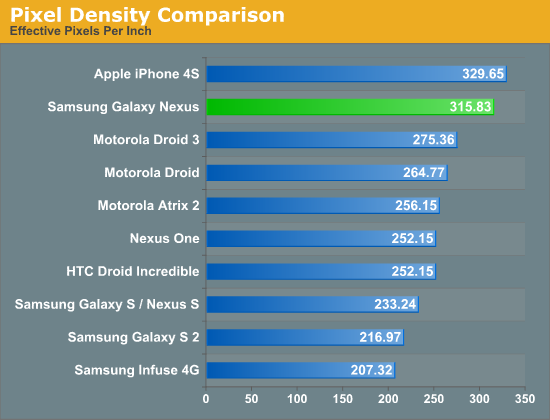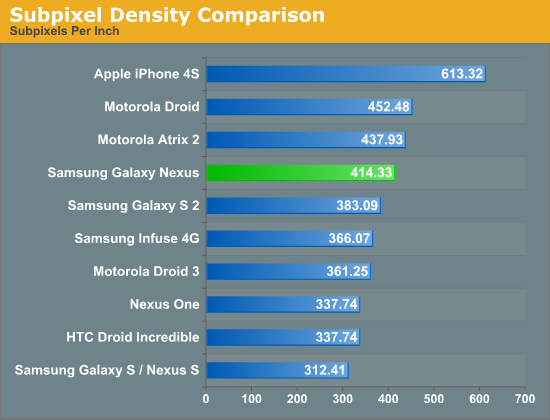Confirmed: Galaxy Nexus Includes PenTile
by Brian Klug & Jason Inofuentes on October 21, 2011 12:58 AM EST- Posted in
- Smartphones
- Samsung
- Ice Cream Sandwich
- Mobile
- AMOLED
- galaxy nexus
Though we've learned a lot about the Galaxy Nexus specifications already, one of the things that has remained a question thus far is whether its 4.65" 720p HD Super AMOLED display uses an RGB subpixel rendering layout or PenTile. We've now confirmed that the Galaxy Nexus display does in fact use RGBG PenTile, like all the Nexus devices to date. This isn't super surprising considering that Samsung has been pretty good about adhering to all the monikers it has gradually been tacking onto AMOLED. There are a number so far - 'super' connotes an optically bonded panel and digitizer stack, 'plus' connotes an RGB stripe, and now 'HD' connotes, well, 720p. HD Super AMOLED lacks Plus, and thus isn't an RGB stripe.
The next question is just what 4.65" HD Super AMOLED will look like, or whether the presence of PenTile will be as noticeable as previous AMOLED phones like the Nexus S / Galaxy S or Nexus One where it was arguably very noticeable. That said, at some subpixel density it should become difficult to impossible to notice PenTile's presence, it's just a matter of exceeding human visual acuity. Having not seen the Galaxy Nexus in person yet and given the absence of good macro shots of the display, we have put together a numerical comparison pitting the Galaxy Nexus panel up against some other common smartphone displays.
First up is a quick plot of the effective pixel density of some popular displays. Stated another way, this is the pixel density based on the manufacturer's stated logical resolution, which is also the resolution of Android's render target for the phone.

Note that this is the traditional means of reporting pixels per inch that we've published before. However, using this metric is just a bit misleading since it doesn't take into account the difference between 2 subpixel-per-pixel RGBG or RBGW PenTile versus the 3 subpixel-per-pixel RGB stripe. To make for an effective comparison, we've put together another plot where we take into account the presence of PenTile and report subpixel density.

Here things still look pretty good for the 4.65" HD Super AMOLED display, putting it just north of SGS2's Super AMOLED Plus display with an RGB stripe. I wager that if you were satisfied with the pixel density of SGS2 that the pixel density Galaxy Nexus actually won't be off-putting despite the presence of PenTile. In addition, hopefully some of the UI design considerations that come along with using PenTile (no vertical 1 pixel thick elements) have been taken into consideration from the outset for Ice Cream Sandwich. For true subjective impressions however, we'll have to wait and see.
Source: Data










152 Comments
View All Comments
solarein - Wednesday, October 26, 2011 - link
This is a ridiculously convoluted way of doing a very simple calculation. What you are doing is just calculating the number of RGB-equivalent pixels of the Galaxy Nexus, then diving that by the area and taking the square root to get the RGB-equivalent pixel per inch of the phone. What you could have done is simply calculate the dimensions of the Galaxy Nexus screen using the diagonal and the aspect ratio, and get 4.05in X 2.28in, and then do:sqrt(1280*720*(2/3) / (4.05*2.28)) = 257.9 RGB-equivalent pixels per inch, which you got.
What you also don't realize is that this number prove the numbers in your second graph to be incorrect. You can get from the number of RGB-equivalent pixels per inch to the number of subpixels per inch by multiplying by sqrt(3) (because the square of sqrt(3) is 3, which is the ratio of subpixels to pixels per square inch of screen). For the Galaxy Nexus you get
257.9*sqrt(3) = 446.7
And for the iPhone 4 you get
329.7*sqrt(3) = 571.1
These are the correct numbers for the subpixel per inch of each phone. Notice that in this case you use sqrt(3) for the Pentile screen, not sqrt(2) because the 257.9 is the RGB-equivalent number of pixels per inch. If you use the actual number of pixels per inch, 315, then you multiply by sqrt(2) instead to get the subpixels per inch, and you still end up with 446.7.
solarein - Wednesday, October 26, 2011 - link
An even simpler way of thinking about this is by noticing that, since the Pentile screen has 2/3 the number of subpixels as the RGB screen, you can pretend that in each dimension it has sqrt(2/3) the number of pixels, so that when you take the area you end up with 2/3 the number of pixels, which is what you want. Once you have this, converting from the pentile PPI to the RGB equivalent PPI is as simple as multiplying by sqrt(2/3).